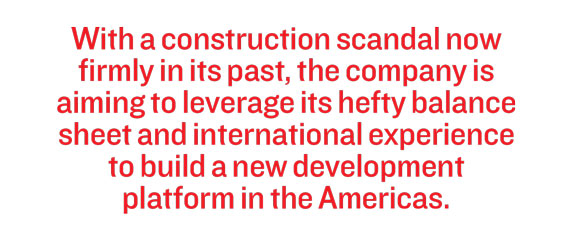It’s hard to miss Melissa Burch.
For starters, as a top executive at construction giant Lend Lease, she’s a woman operating in what’s commonly seen as a man’s world. Second, at six feet tall — without heels — the statuesque brunette stands out before even uttering a word.
“I still do a double-take sometimes when I see pictures of myself with other people,” she joked. “I forget how tall I am.”
Burch has always embraced her height, but she’s likely more grateful than ever before for the visibility it affords her.
That’s because in 2015, Lend Lease hired her away from Forest City Ratner to become its new executive general manager.
The company is aiming to leverage its hefty balance sheet and international experience to build a new development platform in the Americas. And New York is on top of its hit list of places to deploy its capital, followed closely by Boston and Chicago.
Burch, 39, will be at the helm of that new effort. The company — which in New York has exclusively focused on construction until now — undoubtedly has a leg up here, having built residential behemoths for other developers such as 432 Park Avenue and One57, as well as landmarks like the National September 11 Memorial & Museum and CitiField.
But despite its high-profile projects, it faces some significant challenges — from competing with its developer clients to going up against rivals who are increasingly tapping cheaper, non-union labor. That’s not to mention that this new push comes just a few years after the company settled a giant overbilling fraud scandal with U.S. prosecutors.
Plus, there’s the general difficulty of getting into the development game in New York, where the barriers to entry are high.
“No one has managed to do it yet,” Forest City Ratner’s CEO MaryAnne Gilmartin, Burch’s former boss, told The Real Deal. “That might mean it’s fertile ground — or it might not.”
Global giant
Founded in 1951, the publicly traded Australian firm, formerly known as Bovis Lend Lease, is a giant in the development business — just not in the U.S.
It’s developed massive projects all over the world, including Barangeroo, a $6 billion office-and-retail project on Sydney Harbour, and a $2 billion redevelopment in London’s Elephant and Castle neighborhood, which includes the construction of more than 3,000 new homes.
Its coffers are well lined. As of June 30th, its investment management arm had approximately $15 billion in property assets under management on behalf of pension funds, insurance companies and sovereign wealth funds.
“Globally, they have 12 projects at the scale of [Brooklyn’s] Atlantic Yards happening all over the world,” Burch said of Lend Lease. “They’re comfortable at a scale that’s quite significant.”
Three years ago, the company’s board pledged to expand its business globally. With the U.S. economy improving, New York and other major U.S. cities topped the list of prospective investment areas.
Michael Stern, CEO of the Manhattan-based JDS Development Group, which handles its own construction, said the shift into development is a smart one.
“You’re seeing a lot of developers go into the construction space, but why not the other way?” he said. “It makes sense.”
Burch said her company’s experience in construction will be a boon to its development goals, especially in an environment where construction costs are escalating faster than ever. In 2014, construction costs rose to $32.9 billion in New York City, up 5 percent from $28.2 billion in 2013, according to the New York Building Congress.
Burch argued that the company has an advantage when it comes to breaking into development in New York because it understands the construction process inside out.
“It means we can get much better information much earlier in the process of underwriting a deal,” she said. “I can make better assumptions about costs based off of real-time data on what’s happening in construction. Hopefully, that means the costs of my deals won’t migrate the way others’ have.”
Burch also contended that the company’s relationships with developers would help it source deals fast. That’s what happened at 281 Fifth Avenue, where it’s co-developing a $400 million, 52-story, 260,000-square-foot condo project.
Victor Group, its partner in the deal, was a longtime construction client. When Lend Lease’s executives learned that Victor was looking for a partner they quickly called their development counterparts.
That project not only shows how much its construction connections might feed its development operation, but is also an early sign of the kind of flashy deals it’s already going after.
The partnership has tapped starchitect Rafael Viñoly, who’s also behind 432 Park, to design the trophy tower, which is expected to have ambitious price tags.
Lori Golub, general counsel and COO of HFZ Capital, who worked with Burch at Forest City, said she expects big things from her former colleague.
“She’s taken a very big job,” Golub said. “The way for her to make her mark and let the world know that Lend Lease is now a player in this market was to do something splashy. That’s what she’s done.”
Challenging terrain
Despite its wealth of experience overseas, Lend Lease has challenges ahead, especially when it comes to squaring the priorities of its development and construction businesses, said Gilmartin.
“They need someone like Melissa to get contractors to think like developers,” Gilmartin said. “The DNA is typically just different between the two. In contracting, there’s an aversion to risk and an inability to take more of a long-term view on an investment. Development is more a labor of love. Those two things aren’t necessarily a good match.”
In a broader sense, the company also took a big hit in 2012 when it agreed to pay $55 million in fines and restitution to avoid criminal charges for overbilling government and private clients, among other scams. The former head of the company’s New York operations, James Abadie, pleaded guilty to his role in the scheme and was sentenced to two years of probation.
 Prosecutors said the case, which they deemed the biggest construction fraud scandal in New York City history, was emblematic of the widespread corruption in the construction industry.
Prosecutors said the case, which they deemed the biggest construction fraud scandal in New York City history, was emblematic of the widespread corruption in the construction industry.
But Lend Lease’s Americas CEO Denis Hickey said the company has moved beyond the scandal and implemented safeguards, including bringing on a professional ethics executive who must sign off on construction contracts, to ensure nothing similar happens again.
“We’ve put that well behind us,” he told TRD. “We spent a lot of time fixing it and it’s not a factor anymore.”
Still, when it comes to breaking into development, there’s also the unrelated uncertainty as to how Lend Lease’s clients might react to bidding against the company for a project. Can they trust Lend Lease to help them pencil out a deal when the construction giant may compete for the same deal or if there is an inherent conflict of interest?
At least some clients said it’s not a concern. “Given their history with development, they know what they are doing and probably won’t have a problem,” said Jordan Barowitz, a spokesman for the Durst Organization, one of Lend Lease’s frequent clients.
For Burch, Lend Lease’s dual business is all part and parcel of the industry.
“Developers are used to partnering with someone on one deal and then competing with them on another,” she said. “I’m sure there will be folks wondering how that might play … but for the most part, they’re also seeing that there’s opportunity there.”
Then there’s the question of what Lend Lease’s “construction DNA” means in an environment where developers are increasingly flirting with non-union construction. By the end of 2015, almost 50 percent of all New York City projects will have been built using some non-union construction, said Barry LePatner, an attorney and construction expert.
Yet Lend Lease’s in-house construction team is an exclusively union shop in New York, so it’s possible that Lend Lease may lose an edge in competing on deals.
“That’s something they’re going to have to work out internally,” said George Kruse of Equity Residential, a Lend Lease construction client. “The construction side is in the business of making money, after all, and they’ll bid exactly what they would for any other development.”
Hickey, a native of Australia, said the construction side of the business will not hold back the development side — or vice versa.
“If the project doesn’t fit a Lend Lease style of construction then we are open to using a third-party business,” he said. “We have done that elsewhere when it was the right thing to do.”
Either way, the road ahead is paved with risk for Lend Lease, LePatner said.
“If you’re going to compete with well-established New York City developers who’ve been doing this for years and also handle your own construction, you better know what you’re doing,” he said. “This is playing at very sophisticated levels.”
Climbing the ladder
Burch, a native of Columbus, Ohio, gave up her chance to lead some of the most hotly watched development projects in the city to write her own ticket at Lend Lease.
She landed an internship in 2002 at Forest City Ratner right out of Harvard Business School after cold-calling then-development chief James Stuckey.
Having worked in investment banking and later for tech start-up Urban Fetch, a delivery service, Burch’s decision to go back to business school was partly prompted by her interest in public-private partnerships. That’s what drew her to Forest City.
“I remember sitting in the waiting room for three hours,” she recalled of her internship interview.
Twelve years later, she had worked her way up to executive vice president of commercial and residential development, a position formerly occupied by Gilmartin.
Burch oversaw the development and construction of the nearly $5 billion mixed-used Pacific Park project, formerly known as Atlantic Yards, including its once-faltering experiment with modular construction. She was also managing the development of Cornell Tech’s new futuristic campus on Roosevelt Island.
Given her slate of high-profile projects, her departure at Forest City shocked some.
“She had one of the biggest jobs imaginable so I was surprised when she told me,” said Rick Cook, of COOKFOX Architects, who worked with Burch on Pacific Park. “But, in hindsight, it makes sense.”
“There’s an abrupt and abrasive manner that’s sort of considered okay in the construction industry,” he added. “She brings something completely different, an elegance and a composure, but still manages to keep command of the room. It’s really extraordinary.”
